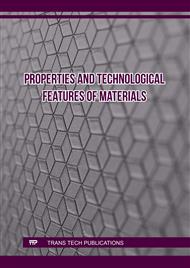[1]
U Messerschmidt 2010 Dislocation Dynamics During Plastic Deformation, Springer, 2010.
Google Scholar
[2]
S.S. Quek, Z. Wu, Y.W. Zhang and D.J. Srolovitz Polycrystal deformation in a discrete dislocation dynamics framework, Acta materialia 75 (2014) 92-105
DOI: 10.1016/j.actamat.2014.04.063
Google Scholar
[3]
K.M. Davoudi and J.J. Vlassak Dislocation evolution during plastic deformation: Equations vs. discrete dislocation dynamics study, Journal of Applied Physics 123 (2018) 085302
DOI: 10.1063/1.5013213
Google Scholar
[4]
R.B. Sills, W.P. Kuykendall, A. Aghaei and W. Cai Fundamentals of dislocation dynamics simulations Multiscale materials modeling for nanomechanics (Springer, Cham) (2016) 53-87
DOI: 10.1007/978-3-319-33480-6_2
Google Scholar
[5]
R.J. Amodeo and N.M. Ghoniem Dislocation dynamics. I. A proposed methodology for deformation micromechanics, Physical Review B 41 (1990) 6958. https://doi.org/10.1103/PhysRevB. 41.6958
DOI: 10.1103/physrevb.41.6958
Google Scholar
[6]
J. Segurado, J. LLorca and I. Romero Computational issues in the simulation of two-dimensional discrete dislocation mechanics, Modelling Simul. Mater. Sci. Eng. 15 (2007) 361
DOI: 10.1088/0965-0393/15/4/S04
Google Scholar
[7]
S.M. Keralavarma, T. Cagin, A. Arsenlis and A.A. Benzerga Power-law creep from discrete dislocation dynamics, Physical Review Letters 109 (2012) 265504
DOI: 10.1103/PhysRevLett.109.265504
Google Scholar
[8]
J. Bai, Q. Bai, X. He and Q. Zhang Dislocation dynamic simulation of dislocation pattern evolution in the early fatigue stages of aluminium single crystal, International Journal of Nanomanufacturing 13 (2017) 12-22.
DOI: 10.1504/ijnm.2017.10003132
Google Scholar
[9]
M. Jiang Investigation of grain size and shape effects on crystal plasticity by dislocation dynamics simulations Doctoral dissertation Université Paris Saclay (COmUE), 2019.
Google Scholar
[10]
S. Queyreau, G. Monnet and B. Devincre Slip systems interactions in α-iron determined by dislocation dynamics simulations, International Journal of Plasticity 25 (2009) 361-377
DOI: 10.1016/j.ijplas.2007.12.009
Google Scholar
[11]
M. Jiang, G. Monnet and B. Devincre On the origin of the Hall–Petch law: A 3D-dislocation dynamics simulation investigation, Acta Materialia 209 (2021) 116783
DOI: 10.1016/j.actamat.2021.116783
Google Scholar
[12]
J. Durinck, B. Devincre, L. Kubin and P. Cordier Modeling the plastic deformation of olivine by dislocation dynamics simulations, American Mineralogist 92 (2007) 1346-1357
DOI: 10.2138/am.2007.2512
Google Scholar
[13]
B. Devincre, L. Kubin and T. Hoc Physical analyses of crystal plasticity by DD simulations, Scripta materialia 54 (2006) 741-746
DOI: 10.1016/j.scriptamat.2005.10.066
Google Scholar
[14]
W. Blum Role of Dislocation Annihilation during Steady State Deformation, physica status solidi (b) 45 (1971) 561-571
DOI: 10.1002/pssb.2220450219
Google Scholar
[15]
G.A. Malygin Dislocation self-organization processes and crystal plasticity, Physics-Uspekhi 42(9) (1999) 887.
DOI: 10.1070/pu1999v042n09abeh000563
Google Scholar
[16]
U.F. Kocks and H. Mecking Physics and phenomenology of strain hardening: the FCC case, Progress in materials science 48 (2003) 171-273.
DOI: 10.1016/s0079-6425(02)00003-8
Google Scholar
[17]
O. Skibitzki, M.H. Zoellner, F. Rovaris, M.A. Schubert, Y. Yamamoto, L. Persichetti, L. Di Gaspare, M. De Seta, R. Gatti, F. Montalenti and G. Capellini Reduction of threading dislocation density beyond the saturation limit by optimized reverse grading, Physical Review Materials 4 (2020) 103403
DOI: 10.1103/PhysRevMaterials.4.103403
Google Scholar
[18]
H. Mecking and U. F. Kocks Kinetics of flow and strain-hardening, Acta metallurgica 29 (1981) 1865-1875
DOI: 10.1016/0001-6160(81)90112-7
Google Scholar
[19]
J.P. Hirth and J. Lothe 1982 Theory of Dislocations, 2nd ed. Wiley, New York, 1982.
Google Scholar
[20]
G.A. Malygin Kineticheskiy mekhanizm obrazovaniya periodicheskikh dislokatsionnykh struktur, FTT 31.1 (1989) 175/in russian
Google Scholar
[21]
G. A. Malygin Kineticheskiy mekhanizm obrazovaniya polos sbrosa pri plasticheskoy deformatsii kristallov, FTT 32.4 (1990) 1102/in russian
Google Scholar
[22]
C. Keller and E. Hug Kocks-Mecking analysis of the size effects on the mechanical behavior of nickel polycrystals, International Journal of Plasticity 98 (2017) 106-122
DOI: 10.1016/j.ijplas.2017.07.003
Google Scholar
[23]
V. I. Vladimirov and A. E. Romanov Kooperativnyye deformatsionnyye protsessy i lokalizatsiya deformatsii (Kiev: Naukova Dumka) (1989) 101/in russian
Google Scholar
[24]
E.I. Galindo-Nava, J. Sietsma and P. E. J. Rivera-Díaz-del-Castillo Dislocation annihilation in plastic deformation: II. Kocks–Mecking Analysis, Acta materialia 60 (2012) 2615-2624
DOI: 10.1016/j.actamat.2012.01.028
Google Scholar
[25]
K. Hariharan and F. Barlat Modified Kocks–Mecking–Estrin Model to Account Nonlinear Strain Hardening, Metallurgical and Materials Transactions A 50 (2019) 513-517
DOI: 10.1007/s11661-018-5001-9
Google Scholar
[26]
K. Borysovska, V. Slyunyayev, Y. Podrezov, Z. Pakiela and K. Kurzydlowski Influence of the dislocation structure on the crack tip in highly deformed iron, MATERIALS SCIENCE-WROCLAW 23 (2005) 521.
Google Scholar
[27]
K. Borysovska and Y. Podrezov Analysis of annihilation conditions of dislocation clusters, Mathematical Models and Computing Experiment in Material Science 7 (2005) 99/in russian
Google Scholar
[28]
K. Borysovska, Y. Podrezov and S. Firstov Critical density of dislocations during their rearrangement into polygonization walls, Electron Microscopy and Strength of Materials 25 (2019) 3/in Russian http://www.materials.kiev.ua/article/2896
Google Scholar
[29]
K. Borysovska, Y. Podrezov and S. Firstov Dislocation dynamics in the polycrystal in the presence of disclination wall, Electron Microscopy and Strength of Materials 21 (2015) 7/in Russian http://www.materials.kiev.ua/article/1725
Google Scholar
[30]
K. Borysovska, Y. Podrezov and S. Firstov , N. Marchenko Modeling of the phenomenon of brittle-plastic transition by the method of dislocation dynamics, Uspihi materializnavstva 4/5 (2022) 25/in Ukrainian
DOI: 10.15407/materials2022.04-05.025
Google Scholar


